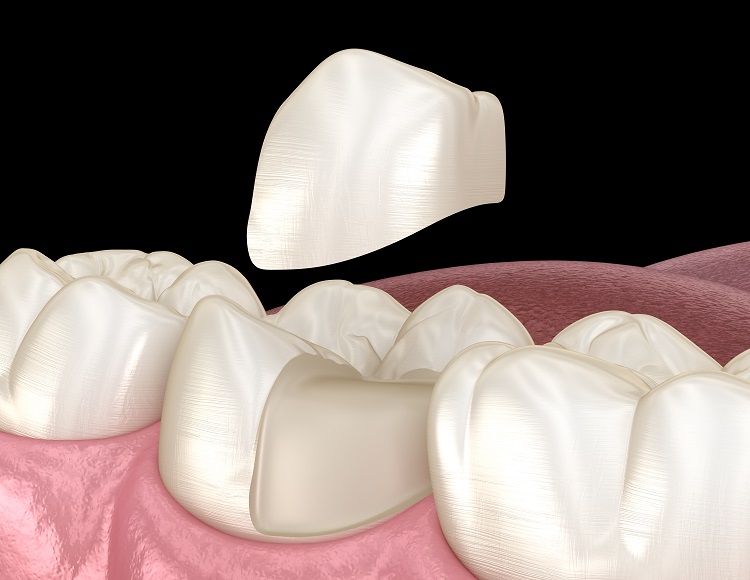What are dental inlays and onlays?
What steps are involved in filling a tooth?
First, the dentist will use a local anesthetic to numb the area around the tooth being filled. Next, a drill, air abrasion instrument, or laser will be used to remove the decayed area. The choice of instrument depends on the individual dentist's skills and experience, dental equipment as well as the location and extent of the decay.
Next, the dentist probes and checks the teeth to make sure the decay has been completely removed. They then clean the bacteria and debris from the teeth to prepare the filling space. If cavities are near the root, the dentist may place a glass ionomer, composite... lining to protect the nerve. After the filling is completed, the teeth will be polished.
What types of filling materials are available?
Today, there are many materials used to fill teeth. Teeth can be filled with gold, porcelain, silver amalgam (which is a combination of mercury and silver, tin, zinc, and copper); or tooth-colored, plastic materials called composite resin fillings. In addition, there is a material containing glass particles called glass ionomer, used in ways similar to composite material.
The location and extent of the decay, cost of filling material, your insurance coverage, and your dentist's recommendation assist in determining the type of filling best for you.
What are indirect fillings?
Indirect fillings are similar to those of composite or other materials; however, fillings are made in a dental laboratory. To do indirect fillings, you must visit your dentist twice.
This technique is performed when the tooth structure is not good enough for direct fillings but the tooth has not been severely damaged that it needs a crown.
At the first visit, the old fillings or cavities will be removed and cleaned. The dentist will then take a tooth impression to get the shape of the tooth being repaired and the surrounding teeth.
The impression is sent to a dental lab that will make the indirect filling. A temporary filling is placed to protect the tooth while the restoration is being made.
During the second visit, the dentist will remove the temporary fillings and check the fit of the indirect filling. After everything is stable, it will be permanently cemented into place.
There are two types of indirect fillings - Inlays and Onlays:
- Inlays are similar to fillings but the entire work lies within the cusps (bumps) on the chewing surface of the tooth.

- Onlays are more extensive than inlays, covering one or more cusps. Onlays are sometimes called partial crowns.

Inlays and Onlays are more durable and last much longer than traditional fillings - up to 30 years. They can be made of composite resin, porcelain, gold or silver amalgam. Inlays and onlays weaken the tooth structure, but in a much lower extent than traditional fillings.
Besides, there is another type of inlay and onlay called direct inlays and onlays, which follows similar processes as the indirect, but the difference is that direct inlays and onlays are made right in the dental office and can be placed in one visit. The type of inlay or onlay used depends on how much sound tooth structure remains and consideration of any cosmetic concerns.
Why do you need temporary fillings?
You may need to get temporary fillings in the following cases:
- Fillings process takes many visits to be done, such as indirect fillings
- Root canal treatment needed
- Calming tooth nerves if the root canal is irritated
- Other urgent dental problems like a toothache.
A temporary filling is just a solution to protect teeth in a short time. Fillings often fall off or flake off and wear off within a few months. So make sure you can set a time to get your fillings permanently placed; otherwise, your teeth could become infected or cause unpredictable complications.
Are silver amalgam fillings safe?
Over the years, there is still much doubt about the silver amalgam fillings. They contain mercury and it is said to affect health, causing a number of diseases including Alzheimer's, autism, multiple sclerosis.
The American Dental Association (ADA), FDA, and many public health organizations say there is no evidence that amalgam fillings are harmful to the health of patients. In addition, there is no reliable scientific evidence to claim that removing the amalgam fillings can cure these above disorders.
However, in June 2008, the FDA announced that amalgam containing mercury could cause neurotoxic effects in children and developing fetuses. Therefore, pregnant women and those with health conditions that make them more sensitive to mercury exposure, including those with high levels of bio-mercury, should carefully discuss with their dentist to choose an appropriate dental treatment.
How should you care for your teeth with fillings?
To maintain fillings, you should follow good oral hygiene, regularly visit the dentist to scrape tartar and have other dental check-ups. You should also brush your teeth with fluoride toothpaste, floss and use an antibacterial mouthwash at least once a day.
If the dentist suspects a filling might be cracked or is "leaking", he or she will take X-rays to assess the situation. If your tooth is extremely sensitive, if your teeth become more sensitive or you notice a crack in the filling, try to visit your dentist for timely treatment.
A set of bright and healthy teeth makes a large contribution to a beautiful smile. So what to do to protect your oral health in the best way? You and your family should have regular dental check-ups every 6 months to promptly detect oral diseases if any and choose the proper treatment.
Reference source
Services
Working Time
- Monday - Friday: 08:00 - 19:00
- Saturday: 08:00 - 18:00
- Sunday closed
Contact Info
- Hotline 1: (+84) 908 321 455
- Hotline 2: (+84) 931 857 885
- Mobile: (+84) 8 3925 8778
- Phone: (+84)2 838 258 778
- info@dentalrose.net
- rosedentalclinicvn@gmail.com
 English
English  Tiếng Việt
Tiếng Việt

